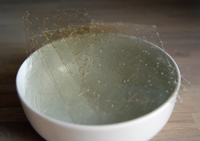
Photo from wikipedia
Development of biological dressings has received widespread attentions due to their good breathability, biocompatibility, wettability, and the ability to absorb wound exudate without sticking to the wound. However, current proposed… Click to show full abstract
Development of biological dressings has received widespread attentions due to their good breathability, biocompatibility, wettability, and the ability to absorb wound exudate without sticking to the wound. However, current proposed antibacterial hydrogels are limited antibacterial ability, short service life and insufficient biocompatibility, which are still challenging to address intricate practical applications. Here we develop a cationic peptide-based, salt-responsive hydrogel dressing with triple functions of antifouling, bactericidal, and bacterial release by combining ε-poly-l-lysine, poly(ethylene glycol) diglycidyl ether, and poly(DVBAPS-co-GMA) via a one-pot method. These designed hydrogels enabled to further quaternize to enhance antibacterial property due to the presence of amine residues. The resultant hydrogels present good antibacterial activity (>90%), biocompatibility, cell proliferation efficacy (~400%) and adhesiveness. Through in vivo and in vitro antibacterial capability tests, it is also found that hydrogels have good antifouling and sterilization capabilities, and the sterilization rate could reach up to ~96%. In addition, ~94% of the attached bacterial can be released after saline/water switching for several cycles. Taken together, the designed multiple antibacterial dressing prolongs the lifespan relying on reversible salt-responsive release and meet special requirements for wound healing. This work not only provides a platform to highlight its promising potentials in wound management but also gives a custom strategy to biomedical applications.
Journal Title: International journal of biological macromolecules
Year Published: 2021
Link to full text (if available)
Share on Social Media: Sign Up to like & get
recommendations!